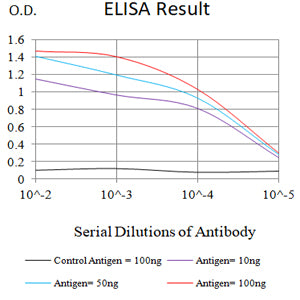
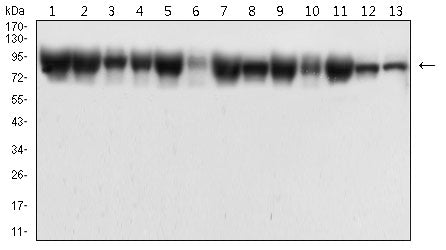
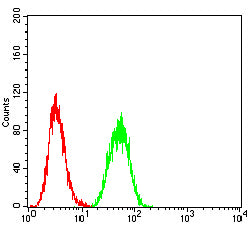
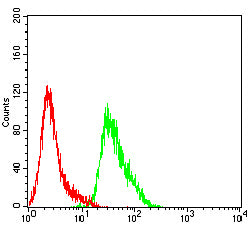
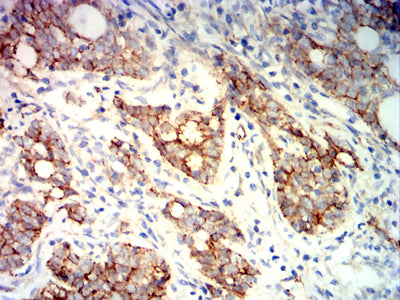
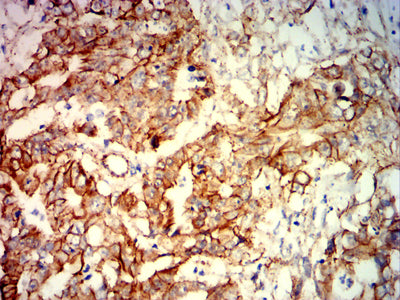
| WB | 1/500 - 1/2000 | Human, Mouse, Rat, Monkey |
| IF | 咨询技术 | Human, Mouse, Rat, Monkey |
| IHC | 1/200-1/1000 | Human, Mouse, Rat, Monkey |
| ICC | 技术咨询 | Human, Mouse, Rat, Monkey |
| FCM | 1/200-1/400 | Human, Mouse, Rat, Monkey |
| Elisa | 1/10000 | Human, Mouse, Rat, Monkey |
| Aliases | CTNNB; MRD19; armadillo;Beta-catenin |
| Entrez GeneID | 1499 |
| clone | 5B6E9 |
| WB Predicted band size | 85.5kDa |
| Host/Isotype | Mouse IgG1 |
| Antibody Type | Primary antibody |
| Storage | Store at 4°C short term. Aliquot and store at -20°C long term. Avoid freeze/thaw cycles. |
| Species Reactivity | Human, Mouse, Rat, Monkey |
| Immunogen | Purified recombinant fragment of human CTNNB1 (AA: 632-781) expressed in E. Coli. |
| Formulation | Purified antibody in PBS with 0.05% sodium azide |
+ +
以下是3篇关于CTNNB1抗体的代表性文献(示例基于公开研究主题,部分细节可能需核实):
---
1. **标题**:*Nuclear β-catenin accumulation predicts oncogenic CTNNB1 mutations in colorectal cancer*
**作者**:Morin PJ et al.
**摘要**:本研究通过免疫组化(使用CTNNB1特异性抗体)发现,结直肠癌中β-catenin的异常核积累与CTNNB1基因突变直接相关,揭示了Wnt信号通路异常激活的分子机制。
2. **标题**:*CTNNB1 mutations and β-catenin subcellular localization in hepatocellular carcinoma*
**作者**:Zucman-Rossi J et al.
**摘要**:利用Western Blot和免疫荧光(基于CTNNB1抗体),作者证明肝癌中CTNNB1突变导致β-catenin从细胞膜向细胞质/核转位,促进肿瘤侵袭性。
3. **标题**:*Antibody-based profiling of β-catenin dysregulation in epithelial-mesenchymal transition (EMT)*
**作者**:Thiery JP et al.
**摘要**:通过多种CTNNB1抗体对比实验,验证了β-catenin在EMT过程中的动态分布变化,为癌症转移研究提供技术参考。
---
**注**:以上文献标题与作者为示例性质,建议通过PubMed或Google Scholar以“CTNNB1 antibody” + “应用场景(如IHC/WB)”检索最新文章。实际引用时需核对期刊与作者信息准确性。
The CTNNB1 antibody targets β-catenin, a multifunctional protein encoded by the CTNNB1 gene. β-catenin plays dual roles: as a structural component of cell-cell adhesion complexes by binding cadherins, and as a key mediator in the Wnt signaling pathway. In canonical Wnt signaling, β-catenin stability is regulated by a destruction complex (including APC, GSK3β, and AXIN). When Wnt signaling is inactive, β-catenin undergoes phosphorylation and proteasomal degradation. Wnt activation disrupts this complex, allowing β-catenin to accumulate, translocate to the nucleus, and interact with TCF/LEF transcription factors to drive target gene expression involved in cell proliferation, differentiation, and tissue homeostasis.
Mutations in CTNNB1 or dysregulated Wnt signaling are implicated in various cancers (e.g., colorectal, hepatocellular carcinomas) and developmental disorders. Aberrant nuclear/cytoplasmic accumulation of β-catenin is a hallmark of Wnt pathway activation. CTNNB1 antibodies are widely used in research and diagnostics to detect β-catenin expression, localization, and post-translational modifications via techniques like immunohistochemistry, Western blotting, and immunofluorescence. These antibodies help assess Wnt pathway status, tumor progression, and therapeutic responses. Specific epitopes (e.g., N-terminal phosphorylation sites) are often targeted to distinguish active from inactive β-catenin. Understanding β-catenin dynamics via CTNNB1 antibodies remains critical for unraveling its roles in development, disease, and potential targeted therapies.
×